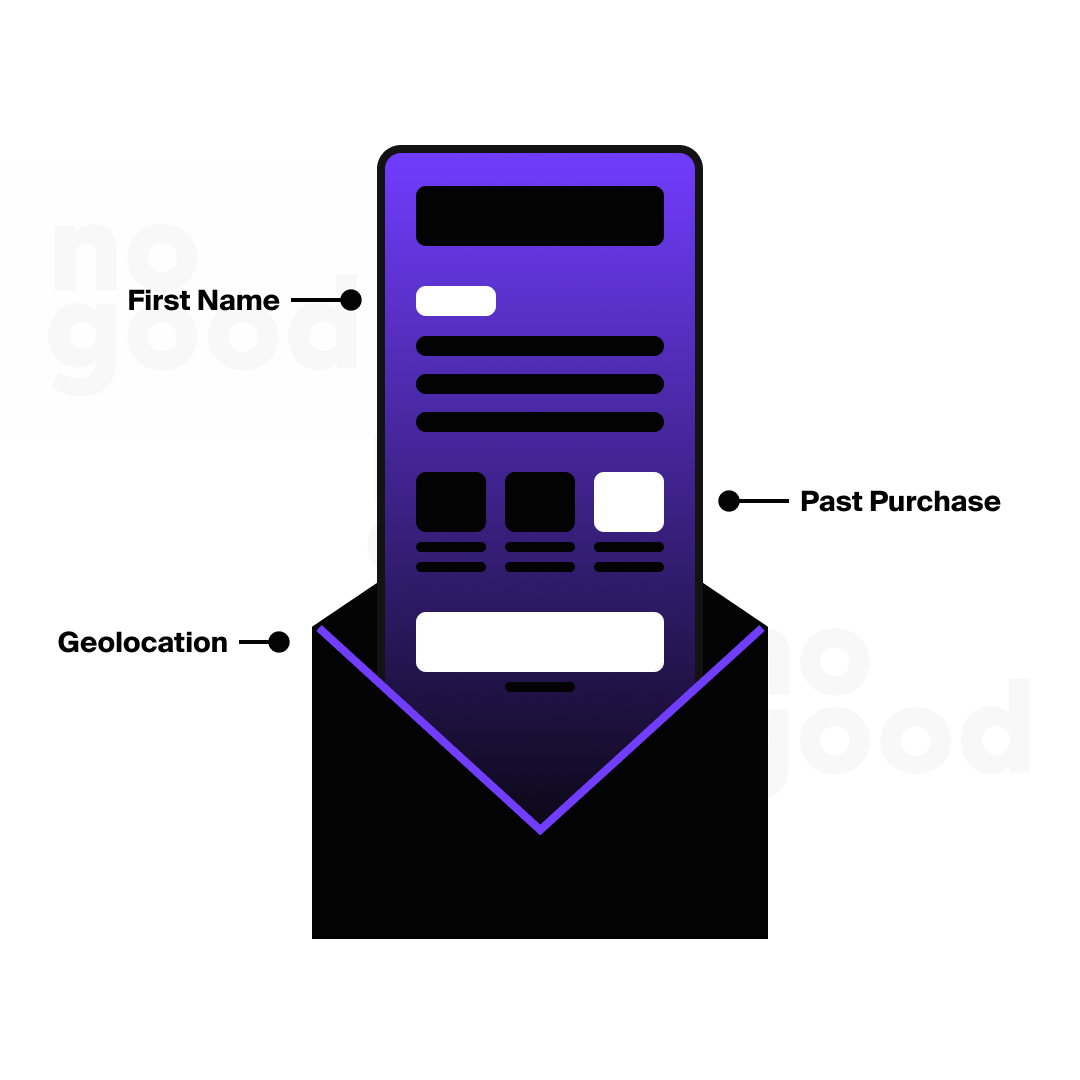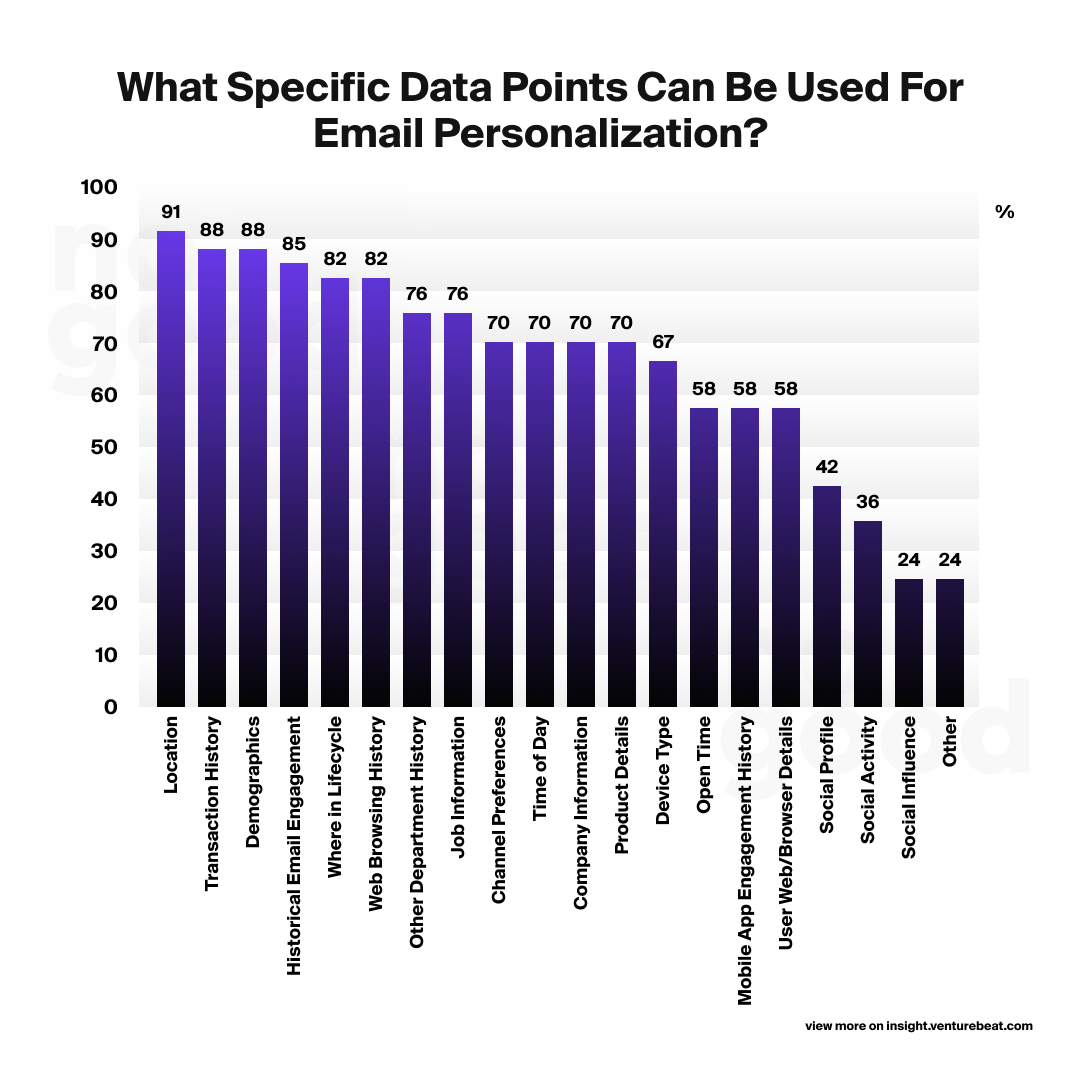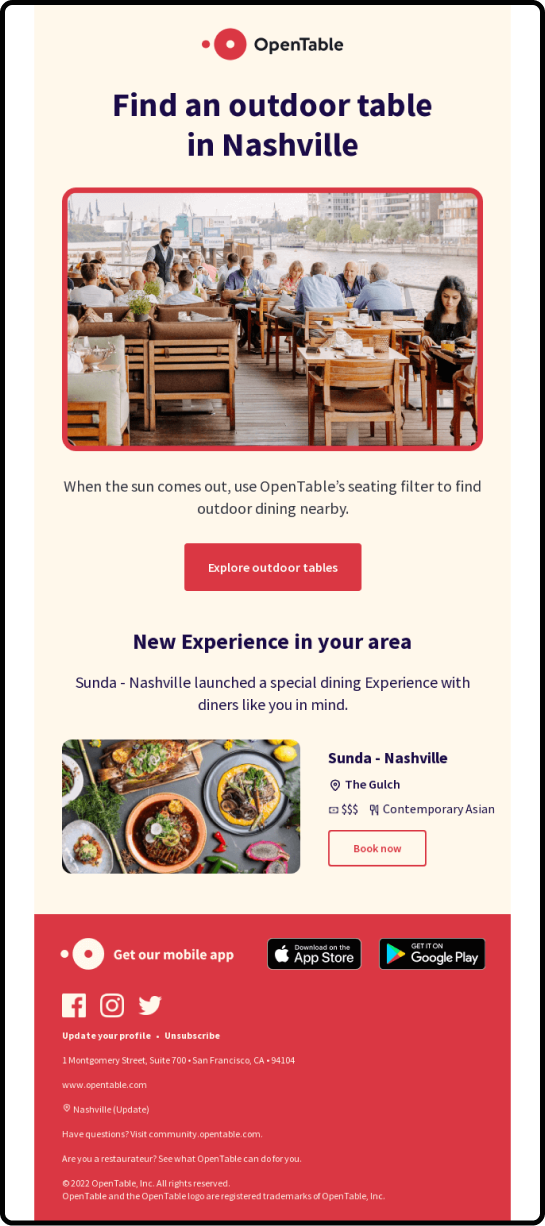On average, a person receives a whopping 121 emails per day. With billions of emails being sent and received each day, it’s crucial for brands to lean on segmentation and personalization to stand out amidst a crowded inbox. Every consumer is different, and there will never be a one-size-fits-all content approach that universally resonates with every person in your customer base. That’s why a large part of email marketing focuses on strategies to ensure that the content being delivered to every consumer is relevant to their needs, pain points, and stage in their user journey.
The demand for personalization, however, raises another concern: How do you deliver on personalization while maintaining scalability and efficiency? The answer lies in dynamic email content, where specific elements of an email automatically change depending on the recipient’s behaviors, preferences, and data.
What is dynamic email content?
Dynamic email content is a powerful technique in email marketing that involves personalizing and customizing email messages for each recipient based on their specific data, behaviors, and preferences. Unlike static emails, which deliver the same message to every subscriber, dynamic content allows marketers to create emails that adapt in real-time to individual recipients.
This means that different users might see different images, offers, product recommendations, or text within the same email campaign, depending on factors such as their past purchases, browsing history, location, or demographic information.

What are the benefits of dynamic email content?
Dynamic email content offers a multitude of benefits that can significantly enhance the effectiveness of your email marketing campaigns. There are three major benefits to using dynamic email content: increased engagement, enhanced brand perception, and efficiency at scale.
1. Increased email engagement
Dynamic email content significantly boosts email engagement by delivering personalized and relevant messages to each recipient. By leveraging user data such as past purchases, browsing history, and preferences, dynamic emails can present tailored content that resonates with individual subscribers. This personalized approach makes emails more appealing and pertinent, leading to higher open rates and click-through rates.
For instance, a customer who recently browsed running shoes might receive an email featuring the latest models and exclusive discounts on athletic gear, making them more likely to engage with the content and complete a purchase. This level of customization ensures that recipients are more invested in the emails they receive, driving better overall engagement metrics for your campaigns.
2. Enhanced brand perception
Using dynamic email content enhances brand perception by demonstrating that your business understands and values its customers. Personalized emails show recipients that you are attentive to their interests and needs, fostering a sense of being cared for and appreciated. This can lead to a stronger emotional connection with your brand, as customers feel that their individual preferences are recognized and catered to.
For example, sending a personalized birthday offer or a recommendation based on past purchases can make customers feel special and valued. This positive perception can translate into increased customer loyalty, as recipients are more likely to trust and favor a brand that consistently delivers relevant and personalized experiences.
3. Efficiency at scale
Dynamic email content allows marketers to achieve efficiency at scale by automating the customization process. Instead of creating multiple email templates for different segments of your audience, dynamic content enables you to design a single template that can adapt based on the recipient’s data. This not only saves time and resources but also ensures consistency across your email campaigns.
By utilizing tools and algorithms to insert personalized elements dynamically, marketers can efficiently manage large-scale campaigns while maintaining a high level of relevance for each recipient. This scalable approach allows businesses to deliver personalized experiences to a broad audience without the manual effort traditionally required, ultimately leading to more effective and streamlined marketing operations.
What are the types of dynamic email content?
Dynamic email content can take many forms, each designed to enhance personalization and relevance for the recipient. These types of dynamic content aren’t mutually exclusive either — they can be combined to create a highly personalized email featuring multiple types of personalization. Here are some of the most common types:
1. Personalized text
Personalized text involves incorporating the recipient’s name, location, or other specific details into the email content. For example, an email might start with “Hi [First Name],” which immediately captures the recipient’s attention and makes the message feel more personal. This simple touch can significantly improve engagement and make the recipient feel valued.
2. Dynamic Images
Dynamic images change based on the recipient’s preferences or behaviors. For instance, an online retailer might use dynamic images to show products that a customer has previously viewed or similar items they might be interested in. This can make the email more visually appealing and relevant, increasing the likelihood that the recipient will click through.
3. Product recommendations
Product recommendations are tailored suggestions based on the recipient’s past purchases, browsing history, or wish list items. These recommendations can be incredibly effective in driving sales, as they present the recipient with items they are likely to be interested in. For example, an email from a book retailer might recommend new releases or bestsellers similar to books the customer has purchased before.
4. Real-time updates
Real-time updates ensure that the content of the email is current at the time it is opened. This can include live countdown timers for sales events, current stock levels, or real-time weather updates. For example, a travel company might use real-time updates to show the current weather at popular destinations, enticing recipients to book a trip.
5. Behavioral triggers
Behavioral triggers are emails sent based on specific actions taken by the recipient, such as abandoning a shopping cart, downloading a resource, or not opening previous emails. These triggered emails can provide timely and relevant content that encourages the recipient to complete a desired action. For instance, an abandoned cart email might remind the customer of the items left in their cart and offer a discount to complete the purchase.
6. Location-based content
Location-based content adapts the email based on the recipient’s geographic location. This can include local store information, regional promotions, or events happening nearby. For example, a restaurant chain might send an email promoting a new menu item available at the recipient’s local branch, making the content more relevant and actionable.
7. Interactive content
Interactive content includes elements such as polls, quizzes, or carousels that allow recipients to engage directly with the email. This type of content can increase engagement by providing a more immersive and interactive experience. For instance, a beauty brand might include a quiz to help recipients find the right skincare products for their skin type, creating a personalized and engaging experience.
8. Dynamic offers and discounts
Dynamic offers and discounts are tailored promotions based on the recipient’s shopping behavior, loyalty status, or previous interactions with the brand. For example, a loyal customer might receive a higher discount or exclusive offer compared to a first-time shopper, incentivizing continued engagement and purchases.
The type(s) of dynamic content that you include in your email will depend on the customer data that you have available. According to a study about the data points most widely used for email personalization, the most common data points used for email personalization are location, transaction history, and demographic information (e.g. age, gender).

What are some examples of dynamic email content?
Let’s take a look at some best-in-class examples of dynamic email content.
1. Netflix
Netflix uses dynamic email content to provide personalized recommendations based on users’ viewing history. For example, after a user finishes watching “The Queen’s Gambit,” Netflix sends an email tailored to their interests. The email opens with a congratulatory note on completing the series and seamlessly transitions into dynamic content that suggests new shows under different categories similar to “The Queen’s Gambit”. Under “Feeling Intellectual?”, Netflix recommends thought-provoking series like “Halt and Catch Fire” or “Alien Worlds.”
For “Play with Your Emotions,” the email highlights emotionally gripping dramas such as “Itaewon Class” or “Away” Finally, under “Continue Watching,” the email includes content that the user has already started but not yet finished, ensuring they can easily pick up where they left off. This level of personalization not only enhances the user experience by offering relevant content but also helps to keep viewers engaged and subscribed to the platform.

2. Loom
User insights and recaps are a common form of dynamic email content used by many SaaS companies. Loom uses dynamic email content to send monthly summaries of users’ activity on the platform, showing data such as their videos created, video views, and meetings eliminated. This dynamic content is beneficial because it provides users with a clear and concise overview of their engagement and productivity, helping them to see the value they are getting from the platform.
By highlighting key metrics and trends, Loom enables users to track their progress and make informed decisions about how to improve their video communication strategies. Additionally, these personalized recaps can motivate users to create more content by showcasing their impact and usage patterns, fostering a sense of achievement and encouraging continued use of the platform.

3. OpenTable
OpenTable effectively leverages dynamic email content to provide highly relevant dining recommendations tailored to the user’s location and current season. For users in Nashville, OpenTable sends personalized emails featuring a curated list of outdoor dining options perfect for enjoying the summer weather. These emails highlight popular local spots with great patios, rooftop seating, or picturesque views, making it easy for users to find the ideal restaurant for their next meal.
Additionally, OpenTable incorporates the user’s previous dining activity into these recommendations, suggesting new places that align with their tastes and preferences. For example, if a user frequently dines at Italian restaurants, the email might suggest similar eateries with outdoor seating.


How do I set up dynamic email content?
Setting up dynamic email content involves several strategic steps to ensure your emails are personalized, engaging, and effective. Here’s a guide to help you get started:
1. Understand your audience
Before diving into the technical aspects, it’s crucial to understand your audience. Segment your email list based on various criteria such as demographics, past behaviors, purchase history, and preferences. The more detailed your segmentation, the more personalized and relevant your dynamic content will be. Use tools like customer surveys, website analytics, and purchase data to gather insights about your subscribers.
2. Choose the right email marketing platform
Selecting an email marketing platform that supports dynamic content is essential. Platforms like Klaviyo, Mailchimp and Braze offer robust features for creating and managing dynamic emails. These platforms allow you to insert conditional content blocks that change based on the recipient’s data. Ensure your chosen platform integrates well with your existing CRM and data sources to streamline the process.
3. Gather and integrate data
Dynamic email content relies heavily on data. Integrate your email marketing platform with your CRM, e-commerce system, and other data sources to pull in real-time information about your subscribers. This integration allows you to use data points such as browsing history, past purchases, or even zero-party data to customize email content dynamically.
4. Design your email template
Create a flexible email template that supports dynamic content blocks. These blocks can include personalized greetings, product recommendations, location-specific information, and other tailored elements. Use conditional logic to define when and how each content block should be displayed. For example, you can set a rule to show a special offer only to subscribers who have made a purchase in the last 30 days.
5. Test and optimize
Before sending your dynamic emails to your entire list, conduct thorough testing. Send test emails to different segments to ensure the dynamic content is displayed correctly and that the personalization rules are working as intended. A/B testing can also help you determine which dynamic elements are most effective. Continuously monitor the performance of your dynamic emails and make adjustments based on open rates, click-through rates, and conversion metrics.
6. Automate and scale
Once you’ve fine-tuned your dynamic email content, automate your email campaigns to ensure timely and consistent communication. Use triggers such as user actions, dates, or behavioral data to send dynamic emails automatically. This automation not only saves time but also ensures that your subscribers receive personalized content at the right moments. As your business grows, scale your dynamic email efforts by adding more data points and refining your segmentation to maintain high levels of personalization and engagement.
Of course, the exact details of how to set up dynamic email content will depend on the specific email marketing platform that you are using. Here are some helpful guides for commonly used platforms:
- Klaviyo: How to use dynamic variables to personalize email and SMS flows
- Klaviyo: How to build dynamic blocks in a flow email
- Iterable: Using Dynamic Content to Personalize Promotional Emails
- Iterable: Dynamic Content Builder
- Mailchimp: About Dynamic Content
- Braze: Understanding Dynamic Content Personalization
As always, if you need more help creating a strategy for dynamic email content, feel free to drop us a line.





